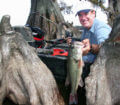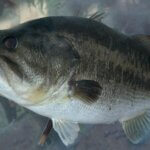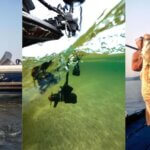Editor’s Note: Larry Nixon of Bee Branch, Arkansas, has fished competitively for 40 years and has won Angler of the Year on the Bassmaster circuit twice, the Bassmaster Classic in 1983 and numerous other tournaments. According to Nixon, who’s won about $4 million in tournaments plus sponsor money, “Bass don’t have rules like fishermen do. For instance, bass don’t know that they are supposed to bite a certain lure of a certain size and a particular color on a specific day, based on water and weather conditions, and where they are in their spawning cycle. Bass are opportunistic feeders, so many times, if you break the rules that most bass anglers hold near and dear to their hearts, you’ll catch bass that other fishermen won’t catch. This week we’re looking at how, where, why and when I break the rules.”
 At many lakes in the United States, you won’t find major underwater drop-offs. There are also certain times of the year when you don’t have to have major abrupt depth changes to catch bass. Often a small underwater depth change can produce a large number of big bass. For instance, you may find a bottom at 5-feet deep and a small drop-off that drops down to 6 or 7 feet, creating only a 2-foot or so depth change. Many times those small breaklines are major highways that bass use to go from shallow water to deep water.
At many lakes in the United States, you won’t find major underwater drop-offs. There are also certain times of the year when you don’t have to have major abrupt depth changes to catch bass. Often a small underwater depth change can produce a large number of big bass. For instance, you may find a bottom at 5-feet deep and a small drop-off that drops down to 6 or 7 feet, creating only a 2-foot or so depth change. Many times those small breaklines are major highways that bass use to go from shallow water to deep water.
Sometimes as anglers work down a breakline, and the water depth begins to change from 5 to 10 feet, to 5 to 8 feet, then from 5 to 7 feet, they will quit fishing. They’ll think that the breakline is playing out, and the bass won’t hold on a 1-2 foot breakline. But these anglers are wrong. I search for these kinds of breaklines. These edges are still the ones that bass are using to move from shallow water to deep water.
These little breaklines are getting less fishing pressure than the big breaklines are because a bass usually doesn’t watch the lure as long – when it falls 1 foot as it does when it falls 5 feet. Often bass instinctively will hit the lure quicker. These 1- to 2-foot breaklines are so small that most fishermen either never see them or never consider fishing them. I really look intensively for these small breaklines when I’m fishing in shallow water because I know these breaklines are major roads that bass travel. I’ll often find maybe one stump or two stumps on the edges of these small breaklines that will hold bass. Perhaps there is a small creek or an underwater road intersecting this small breakline or a cutback in that breakline. When I find those places, I usually can catch bass day after day in an area where no one else will fish.
 Another rule-breaking tactic when I’m bass fishing that I use in conjunction with finding these little breaklines is that I use all kinds of depth finders but depend more on a flasher-type depth finder than I do on others. I can spot these small breaklines much, much better on a flasher. With a flasher, I can see how vertical these little drops are. I can spot stumps, rocks and other structure along this breakline easier and quicker than I can with other depth finders. On the deck of my boat, I have a flasher and other depth finders. When I’m in deep-water situations, I often can see schools of shad better and longer than I can with a flasher. However, the flasher gives me an instant reading, whereas other depth finders give me an instant reading and allow me to look at the picture of the bottom longer than the flasher does.
Another rule-breaking tactic when I’m bass fishing that I use in conjunction with finding these little breaklines is that I use all kinds of depth finders but depend more on a flasher-type depth finder than I do on others. I can spot these small breaklines much, much better on a flasher. With a flasher, I can see how vertical these little drops are. I can spot stumps, rocks and other structure along this breakline easier and quicker than I can with other depth finders. On the deck of my boat, I have a flasher and other depth finders. When I’m in deep-water situations, I often can see schools of shad better and longer than I can with a flasher. However, the flasher gives me an instant reading, whereas other depth finders give me an instant reading and allow me to look at the picture of the bottom longer than the flasher does.
Never be afraid to . . .
* break the rules.
* try something different.
* fish different from all your buddies.
* try a tactic that sounds so off-the-wall that no one in his right mind will fish like that, because if you study what the winners of most bass tournaments are doing, you’ll see that they are breaking the rules that most fishermen live by.
To learn more about bass fishing and get John E. Phillips’ Kindle eBooks, print books and audiobook on bass fishing, go to https://johninthewild.com/books/#bass, or for Nook books, visit www.barnesandnoble.com.










